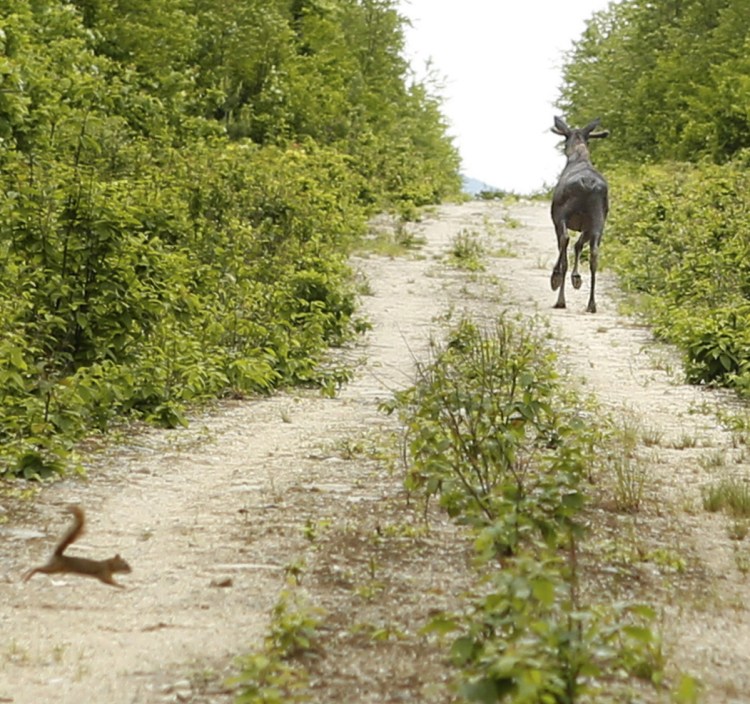If you’ve driven through Maine’s working forestland – which covers three-quarters of the state – you know the unsigned, uneven and unending dirt logging roads are like a no man’s land where automotive breakdowns are common. Anyone unable to fix a flat tire travels at his or her own risk.
“I learned to fix a flat at 10 or 11,” said Christine Barnes of Acton, who grew up hunting at her grandfather’s camp deep in Washington County woods. “I can’t believe there are people who don’t know how to. That’s unreal to me.”
The roadways of Maine’s working forest are primitive dirt byways where sharp rocks are common, and potholes and wash-outs are a way of life. The formidable logging trucks loaded with tree trunks rule the land – or at least the roads – because they own them.
And there’s little to no cellphone service. So if you travel without a patch kit and spare tire, good luck getting help and getting out.
“I’ve had 30 flats in a week-long trip,” said Chris Chase of Falmouth, whose family has a camp south of Jackman in Somerset County. “We just keep plugging the tires and pumping them up.
“The worst I ever saw it was my cousin’s bachelor party. There were probably six or seven trucks and 30 guys, and the bridge in was in real rough shape. Everyone who went over it got a flat. We had a compressor and a plug kit, and I went through all four of my tires and my spare. I got home from Jackman by pulling over every 10 to 15 minutes and pumping the tires back up. It was a lot of fun.”
Needless to say, the rugged folks who go to the Maine woods to hunt, fish and camp are prepared with thick-walled tires, generally 10-ply, a patch kit, air compressors and spare tires – sometimes two.
While growing up at his family’s camp near the Canadian border, Chase, 33, used to drive “beater cars,” and had all kinds of problems, from broken drive shafts and ball joints to “hundreds of flats.”
“You have to just go with it,” Chase said. “The amount of time I’ve been truly stuck, I had someone come along in good fashion and give me a ride into town. It’s part of the adventure. Although in winter it’s different. Because you can freeze to death.”
In September, a post on the Maine Moose Hunting Facebook page by a hunter looking for advice on tires drew 95 responses. And yet woods travelers will tell you flat tires are the least of your worries.
Deep in Maine’s working forest – where you can drive for hours without seeing pavement – there are unearthed boulders that can rip your oil pan, and overgrown trees that will obscure your view and break your windshield. And then there are those logging trucks.
“I had a few instances where I came around a corner and there was a logging truck,” said Barnes, 28. “Either you pick a ditch and pray or end up in front of the truck. Luckily I never wiped out and someone always came along with a tow to get me out of the ditch.”
Barnes always has a flat-tire repair kit, air compressor and spare for her truck.
But once while traveling home from a bear hunt with her uncle, Barnes got a flat on the trailer that carried their ATV. And they didn’t have a spare for that.
So they left it by the side of the road for her grandfather to pick up. They loaded the ATV on the back of the pickup by making it pop a wheelie, then pushing it onto the truck bed. With night falling, Barnes said they had no other choice.
“The thing of it is, that’s normal. You expect that once you spend that much time in the woods,” Barnes said. “You expect stupid stuff to happen.”
Matt Foster of Wilton, who grew up hunting and fishing near Solon, agreed. He spent his youth seeing his share of misadventures.
One time he and his brother got two flats near Chamberlain Lake. The jack in the old truck Foster had just bought didn’t work, so they had to dig under the truck to use it.
“My brother wasn’t impressed with me that day,” said Foster, 34. “As soon as I started making money, I started investing in tires. I figure, do I want to save a few bucks or risk being stranded in the middle of nowhere? When you’re up there, you can’t rely on anyone else.”
Send questions/comments to the editors.



